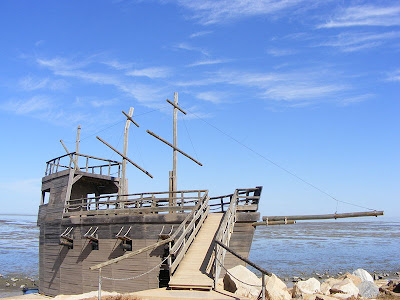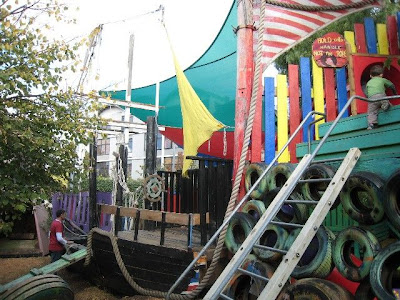Saturday, July 31, 2010
The playgrounds of Constant Nieuwenhuys
Wednesday, July 28, 2010
St. Kilda's Adventure Playground, Melbourne Australia
An amazing four-acre installation...I couldn't stop collecting photos! [from here, there, and everywhere.]
CORRECTION: Thanks to my alert readers for pointing out that these are actually TWO playgrounds, both named St. Kilda's. The wooden castle and boat are from St. Kilda's in South Australia, and the colorful one with tires and slides are from St. Kilda's in Melbourne. So confusing. But both great playspaces!
Saturday, July 24, 2010
Playground (hopefully!) ABCs by Roeland Otten
I previously posted some vintage ABC playground climbers, and posited how nice it would be to see the whole alphabet in playground equipment...Rotterdam designer Roeland Otten has fulfilled my wish with his beautiful set of typographic chairs!
He's looking for a manufacturer that can make these suitable for the outdoor environment, so if you can help get in touch. These would be amazing scaled up from chair size to climber size...imagine spelling the name of your park or school or company! I love the idea of children being able to interact with the elements of language in such a physical way.
[found at dezeen]
Wednesday, July 21, 2010
An Update on La Laguna, and notes on the preservation of historic playgrounds
Happily, the Friends of La Laguna (FoLL) were successful in having the park named to the California Register of Historic Places, and generated an award-winning historic structures report and conservation plan. Major players like the Cultural Landscape Foundation and the National Trust for Historic Preservation are now involved, and their evaluations are required reading for anyone with an interest in preserving their own historic playspace.
The FoLL are forging a new awareness of playgrounds as historic designed landscapes worthy of protected status, and in response California Assembly Member Mike Eng is currently introducing legislation that will indicate that demolition is not the sole fate for playgrounds created prior to the advent of modern safety standards.
It is often said in the US that as California goes, so goes the country, and in this case may it be so!
[photos via the National Trust for Historic Preservation; credit for the vintage photo is to Ron Brown. The blog playgroundology has a nice summary of the La Laguna preservation effort, including an interview with FoLL founders]
Monday, July 19, 2010
Pallet Pavilion, Aarhus School of Architecture, 2010
“The pavilion was basically a strip interacting with its context…leading people to use a different way of crossing the courtyard, by walking and sitting up to 3.50m high. Then, by curving the strip to link and adapt to each element, many steps were naturally created between the pallets, allowing people to sit in the sun, like on a terrace. Since there are no structural elements, the layout and overlapping of the euro-pallets were extremely crucial to insure that the pavilion could be used as the students envisioned. Some pallets are stacked perpendicularly to create a cantilevered condition which provides steps to bring students to the very top of the pavilion, or serve as little seats where users’ feet dangle in the air."
“The Pavilion was meant to become an active element in the everyday-life of the school, and not to be only an object. By adapting naturally to the original flow of people crossing the courtyard, it was inviting people to interact with the structure and to follow the strip to come inside a shelter, built all around the tree.”
Images and text from archdaily
Friday, July 16, 2010
Union Street Urban Orchard (and Playscape!), Heather Ring, 2010
More table tennis...I'm wishing I was back in London to see this temporary garden landscape on an empty lot in Bankside...such good ideas for buildable playable structures and a ping-pong table in a skip! Found at dezeen, the Foundation for Architecture funded project is by Heather Ring (whose waywardplants.org site keeps crashing my browser so no link), and the lovely pavilion is by students and in-house architects from the Aalto University Wood Program, a one-year intensive study of wood and wooden architecture which sounds amazing.
Tuesday, July 13, 2010
The Animal Court at the Jane Addams Homes, Chicago, Edgar Miller, 1938
The Jane Addams Homes were a 1930s demonstration project of the Public Works Administration Act, drafted to alleviate the unemployment of the Great Depression. Designed by a team of architects headed by John Holabird, they offered child care, employment counseling and a variety of other pioneering social services in addition to housing. AND they had the fantastic creatures of what became known as the Animal Court, a set of limestone carvings by Chicago artist Edgar Miller arrayed in an avenue grand enough for any palace and enlivened by what must be an early example of a splash park. (For more on Miller, see the recently published book: Edgar Miller and the Hand-Made Home: Chicago's Forgotten Renaissance Man )
)
By 2005, they were in an advanced state of deterioration, isolated in a razed landscape, no trace of the water playground.
By 2007 the community organized to save them, and there was fund-raising and splashy press releases and hoorays and congratulations and the sculptures were moved to a conservation studio for restoration. Where they have sat for now three years, without the funding promised by developers Related Midwest.
But a better idea is afoot, to resite the statues at the only remaining building from the historic Jane Addams Homes, which has been preserved to become a National Public Housing Museum, and which I'm sure would be happy to receive your designated contribution towards their restoration, which is estimated to cost $100,000. (Or about the same as two of the boringly similar, primary colory metal playgrounds installed every day of the week somewhere in America, so donate already!) I hope they'll be able to reinstall these beautiful creatures in their original playful context.
[images from Nancy Lorance's site about Jane Addams and the WPA and the National Public Housing Museum. Original reference found at the blog prairiemod]
Friday, July 9, 2010
Ping Pong on the Playground
There was a recent article in the guardian on the burgeoning popularity of ping-pong (table tennis, if you will) in parks and playgrounds--London has installed 47 new tables and the Ping London initiative will place 20 tables in Trafalgar Square in July, and 95 more in high traffic areas like the Tate Modern and Heathrow Airport, a unique way to add playability to these spaces. And that's not to mention the tables Jean Nouvel has installed as part of his red sun-box of a pavilion installation at the Serpentine gallery (you can just see them at the edge of the below image).
I often see concrete tables in parks around continental Europe and rows of them in Asia, but rarely find them in American play spaces, though they're an obvious way to add interest for ages tweens and up, and something for parents accompanying their kids to do beyond sitting on a bench.
A new company, Henge, has started providing a beautifully sculptural version (below) to the US market.
Wednesday, July 7, 2010
East End Community School, Mitchell and Associates, Portland, Maine
The courtyard, shown boringly bare in the above 'before', is considered a reforestation project, and so was planted with herbaceous, understory and canopy plantings of native woodland species in which 'quiet spaces' are provided.
[thanks, sashie!]
Subscribe to:
Comments (Atom)













































